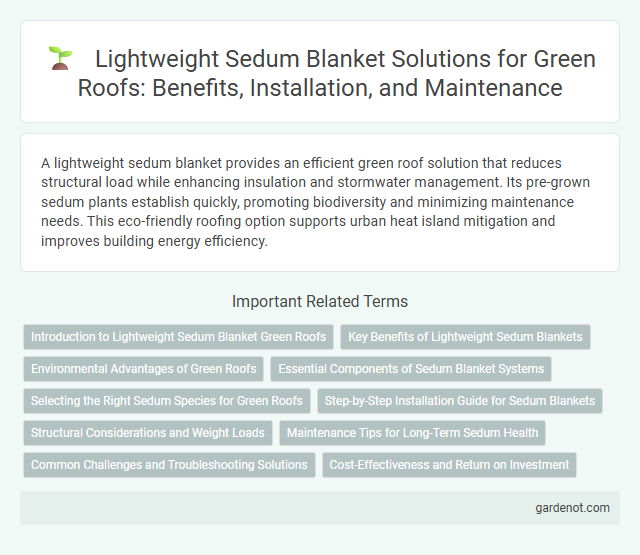A lightweight sedum blanket provides an efficient green roof solution that reduces structural load while enhancing insulation and stormwater management. Its pre-grown sedum plants establish quickly, promoting biodiversity and minimizing maintenance needs. This eco-friendly roofing option supports urban heat island mitigation and improves building energy efficiency.
Introduction to Lightweight Sedum Blanket Green Roofs
Lightweight sedum blanket green roofs provide a sustainable roofing solution by using pre-grown, thin mats of sedum plants that reduce structural load on buildings. These blankets optimize stormwater management, improve insulation, and enhance urban biodiversity with minimal maintenance requirements. Integrating lightweight sedum blankets supports eco-friendly architecture by combining durability, energy efficiency, and aesthetic appeal.
Key Benefits of Lightweight Sedum Blankets
Lightweight sedum blankets offer excellent insulation properties, reducing energy costs by minimizing heat loss and gain in buildings. Their modular design promotes rapid installation and reduces structural load, making them ideal for retrofit projects and new builds alike. These blankets also enhance urban biodiversity and stormwater management by efficiently absorbing rainwater and supporting local ecosystems.
Environmental Advantages of Green Roofs
Lightweight sedum blankets on green roofs enhance stormwater management by absorbing significant rainfall, reducing runoff and mitigating urban flooding. These vegetation layers improve air quality by filtering pollutants and capturing airborne particulate matter, contributing to healthier urban environments. Their insulation properties decrease energy consumption in buildings, lowering greenhouse gas emissions and promoting sustainable urban development.
Essential Components of Sedum Blanket Systems
Lightweight sedum blanket systems consist primarily of pre-grown sedum plants layered on a thin substrate mat that provides necessary nutrients and moisture retention. These systems incorporate a drainage layer for optimal water flow and a root barrier to prevent structural damage. Together, these essential components ensure efficient installation, healthy plant growth, and long-term roof protection.
Selecting the Right Sedum Species for Green Roofs
Choosing the right sedum species for a lightweight sedum blanket is crucial for ensuring optimal green roof performance and longevity. Sedum varieties such as Sedum album, Sedum spurium, and Sedum acre are favored for their drought tolerance, shallow root systems, and ability to thrive in shallow growing mediums typical of green roofs. Selecting species adapted to local climate conditions enhances survival rates and maximizes benefits like stormwater management and thermal insulation.
Step-by-Step Installation Guide for Sedum Blankets
Lightweight sedum blankets are pre-grown mats designed for easy green roof installations, providing instant vegetation and erosion control. Begin by preparing a clean, flat substrate and installing an appropriate root barrier to protect the roof membrane. Next, unroll the sedum blanket carefully, ensuring full contact with the substrate, and secure it with biodegradable staples or pins before watering thoroughly to promote root establishment.
Structural Considerations and Weight Loads
Lightweight sedum blankets typically weigh between 15 to 25 pounds per square foot when fully saturated, making structural load calculations critical for safe roof design. Roof structures must be assessed for live load capacity, including the additional weight of the green roof system, soil substrate, and retained water. Engineered framing and reinforced decking are often necessary to support the combined dead and live loads without compromising building integrity.
Maintenance Tips for Long-Term Sedum Health
Lightweight sedum blankets require minimal but consistent maintenance to ensure long-term health, including regular inspection for weeds and pests, as well as occasional watering during extended dry periods. Proper drainage and removing debris help prevent root rot and promote vigorous growth. Fertilizing lightly in early spring supports nutrient availability without causing excessive growth.
Common Challenges and Troubleshooting Solutions
Lightweight sedum blankets often face challenges such as inadequate root establishment, water retention issues, and susceptibility to wind uplift. Troubleshooting solutions include ensuring proper substrate depth, using moisture-retentive growing media, and securing the blankets with biodegradable anchors or soil staples. Regular maintenance and monitoring for pests and nutrient deficiencies help optimize plant health and coverage.
Cost-Effectiveness and Return on Investment
Lightweight sedum blankets offer a cost-effective green roof solution by reducing structural load and installation expenses compared to traditional extensive systems. Their low maintenance requirements and drought-resistant characteristics contribute to long-term savings, enhancing overall return on investment. Rapid establishment and improved stormwater management further increase property value and energy efficiency benefits.
Lightweight sedum blanket Infographic

 gardenot.com
gardenot.com